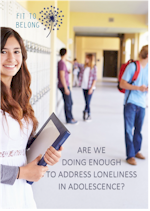This first publication of Fit 2 Belong is the culmination of work conducted in the first phase of the Fit2Belong project. Based on extensive desk research and interviews across Europe with young people aged 14-16 years, the researchers have developed a framework that provides guidance for the development of teaching and learning materials for youth who report loneliness. These materials will be created during the Phases 2 and 3 of the Fit2Belong project.
 This document is the culmination of work conducted in Phase 1 of the Fit2Belong project. Based on extensive desk research and interviews across Europe with young people ages 14-16 years, we have developed a framework that provides guidance for the development of teaching and learning materials for youth who report loneliness. The framework detailed within this report was developed following a thorough review of the academic and grey literature on youth loneliness, which assessed what is already known about loneliness in young people and what has been done about it thus far. We also conducted interviews with young people across five partner European countries exploring loneliness from the perspective of young people in different cultures, something missing from the academic and grey literature. Together, the results from the review and the interviews enabled us to identify foci for targeted intervention to help adolescents cope better with loneliness. The current report summarises what we have learned from the literature search and from young people’s perspectives on loneliness.
This document is the culmination of work conducted in Phase 1 of the Fit2Belong project. Based on extensive desk research and interviews across Europe with young people ages 14-16 years, we have developed a framework that provides guidance for the development of teaching and learning materials for youth who report loneliness. The framework detailed within this report was developed following a thorough review of the academic and grey literature on youth loneliness, which assessed what is already known about loneliness in young people and what has been done about it thus far. We also conducted interviews with young people across five partner European countries exploring loneliness from the perspective of young people in different cultures, something missing from the academic and grey literature. Together, the results from the review and the interviews enabled us to identify foci for targeted intervention to help adolescents cope better with loneliness. The current report summarises what we have learned from the literature search and from young people’s perspectives on loneliness.
This report is kept simple so it is accessible, digestible, and informative for teachers and youth workers, who in Phases 2 and 3 of the Fit2Belong project used the guiding framework to devise intervention sessions to help adolescents cope with loneliness. This report does not include all the detailed stages of either the review process or the interviews, which were published as scientific papers to extend the dissemination of our findings.
The report is available in full in the English and Serbian language, as well as in English, Lithuanian, Dutch, Polish, Portuguese, Serbian and Turkish language in summary.
The application of the research outcomes described in this report is available in all languages in Output 2: The Fit to Belong Handbook, A guide to Belong
| Authors | |
| Files |
|